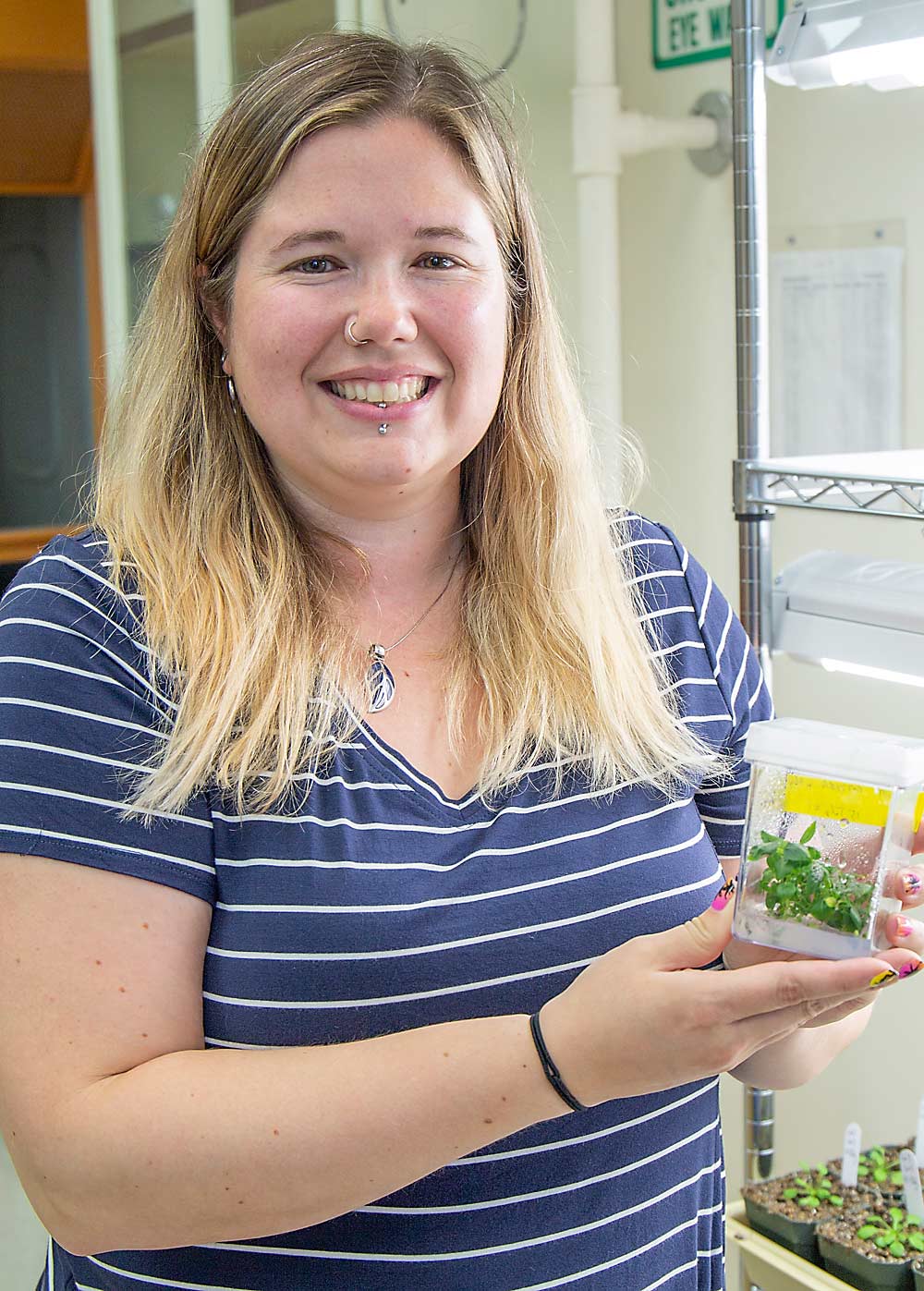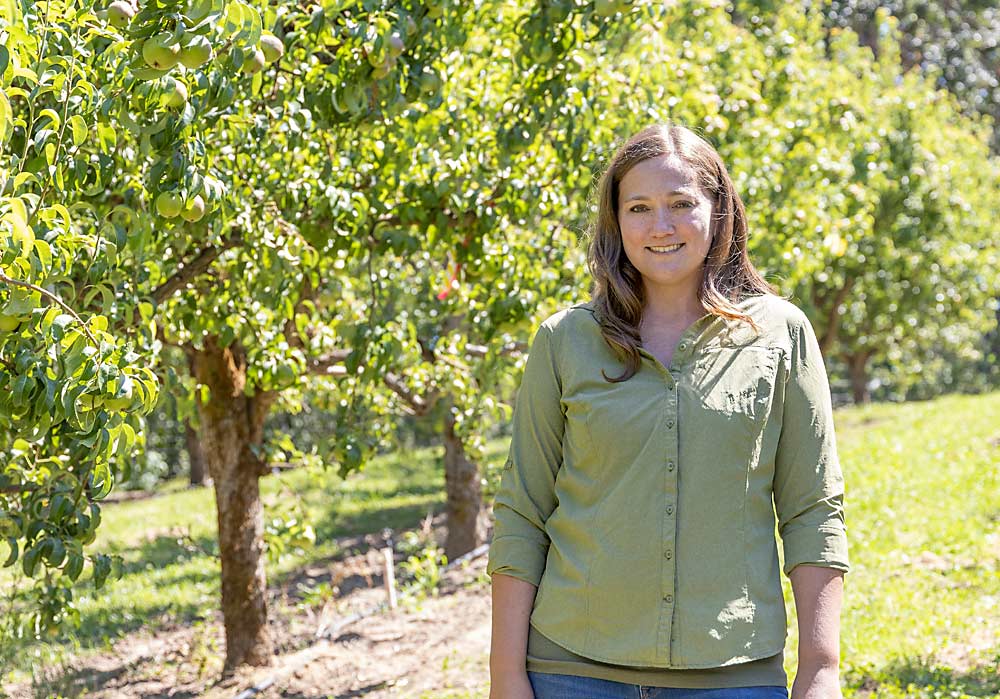
The Pacific Northwest pear industry gained a few new scientists last year. Though the pandemic made it hard for these new hires to get to know the industry in the traditional way, the era of online meetings created new opportunities for pear researchers to connect and strategize.
“When I started, it was kind of hard to figure out who all was working on what,” said Jessica Waite, the new pear geneticist at the U.S. Department of Agriculture’s Tree Fruit Research Lab in Wenatchee, Washington. She started her job during last spring’s shutdown and used the forced time outside the lab to network within the pear research community.
“I organized a virtual meeting of pear researchers this spring for people working in horticulture, physiology and genomics,” Waite said. “It was so good to get everyone in the same virtual room to introduce new people, what everyone is working on, and discuss common issues and ways we can strengthen the research community.”
Talking with another new pear researcher, Kelsey Galimba, who was hired at Oregon State University’s Mid-Columbia Agricultural Research and Extension Center in late 2020, convinced Waite that the pear research community needed more community. Galimba earned her doctorate in molecular biology at the University of Washington, looking at flower development, and then held a postdoctoral research position at the U.S. Department of Agriculture’s Appalachian Fruit Research Station in Kearneysville, West Virginia, which introduced her to tree fruit and applied horticulture.
That position prepared her for her “dream job in her dream location,” working for OSU in Hood River, Galimba said. In her position, she’ll work with pears and cherries.
She inherited several research projects, including a quince rootstock trial for pears, which she plans to expand with new selections, and a Phase 2 trial block of selections from Washington State University’s cherry breeding program. She also assumed work on a cherry bud cold-hardiness model in collaboration with colleagues at WSU.
As for new projects, Galimba is examining biomarkers in cherry for the genes that control the dormancy process and has launched trials of some new plant growth regulators for pears.
When Good Fruit Grower visited in July, Galimba and her colleague, entomologist Chris Adams, who joined OSU in late 2019, were busy cleaning out old laboratories, setting up new equipment and making plans to attract students to work as research assistants at the center. Adams works on projects related to all the major insect pests in the region, including spotted wing drosophila, brown marmorated stink bug, leafhoppers and codling moth.

OSU is investing in the infrastructure upgrades, Adams said, along with support from the local cherry and pear industries. The USDA also has plans to hire a pear postharvest physiologist who will be based at the Mid-Columbia campus but is part of the larger Wenatchee-based research group where Waite works.
The pear geneticist job is a new position there, so Waite has had to set her own priorities. So far, it seems like the perfect role to make use of her research experience, she said. Her previous research experience includes a doctorate from the University of Washington, focused on plant hormones that control growth and development, and then work on the genetics of tree architecture in peach and plum systems and the physiology of sunburn in apples, but no direct work on pears.
In her new role, she will focus on supporting pear rootstock development by looking at root system architecture and the traits that matter for dwarfing and disease resistance. Plant hormones play a role in both of those arenas, she said.
Now, she is busy in the lab developing pear tissue culture capabilities to produce plants for experiments and looking into how biotechnology such as the rapid-cycle breeding system developed for apples, which uses an early flowering gene to significantly reduce generation time, could be developed for pears — specifically pear rootstocks.
“Right now, for pears, the seed-to-seed time is really long,” she said.
That approach, which is used to accelerate breeding fire blight resistance from wild apples into commercial cultivars, for example, would be a huge benefit for pear rootstock and cultivar breeding, said Chris Gottschalk, the new leader of the apple and pear breeding programs at the USDA’s Kearneysville research station.
“If she is able to facilitate that same system in pear, that would revolutionize my program here,” he said. After finishing a doctorate degree at Michigan State University, he joined the station in January to focus on apple genomics research. He also took over “a wealth of germplasm” left by longtime pear breeder Richard Bell.
Gottschalk said that, for pears, he aims first to familiarize himself with the material and what pear producers and consumers want.
“There have been lots of pear releases from the USDA in the last 20 years, but adoption by the industry has been slow,” he said. “With apples, it’s fairly easy to see what consumers want, but we are just not offered other pear cultivars as consumers. It’s hard to figure out and navigate where the industry is going, as a breeder, because we have so many unknowns.”
Connecting with other pear researchers through Waite’s organizing efforts helps, Gottschalk said, because all the puzzle pieces, from dwarfing rootstocks to disease management, contribute to the pears the industry will be producing in the future.
—by Kate Prengaman






Leave A Comment